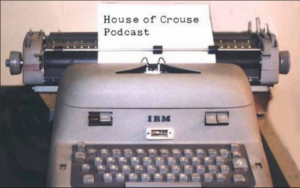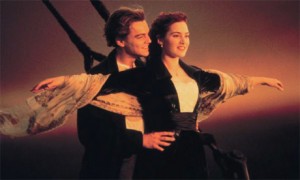CTV NewsChannel: Bill Paxton dies at 61 from complications due to surgery
 Richard appeared on the CTV NewsChannel to talk about the life and legacy of actor Bill Paxton who passed away suddenly this weekend at age 61.
Richard appeared on the CTV NewsChannel to talk about the life and legacy of actor Bill Paxton who passed away suddenly this weekend at age 61.
Watch the whole thing HERE!
 Richard appeared on the CTV NewsChannel to talk about the life and legacy of actor Bill Paxton who passed away suddenly this weekend at age 61.
Richard appeared on the CTV NewsChannel to talk about the life and legacy of actor Bill Paxton who passed away suddenly this weekend at age 61.
Watch the whole thing HERE!
 Richard’s look back at “Titanic” from Cineplex.com: “These days Hollywood routinely thinks in terms of billion dollar grosses. That’s billion with a b. In 2016 the movie biz broke records, raking in north of $11.4 billion and in the last two years eight movies have cracked the billion-dollar threshold.
Richard’s look back at “Titanic” from Cineplex.com: “These days Hollywood routinely thinks in terms of billion dollar grosses. That’s billion with a b. In 2016 the movie biz broke records, raking in north of $11.4 billion and in the last two years eight movies have cracked the billion-dollar threshold.
“In 1990s, however, those numbers were a rarity. Jurassic Park stomped all over its competition in 1993 but it took the story of a sinking ship to float to the very top of the box office. For a good chunk of the Clinton years (Bill, not Hillary) Titanic, James Cameron’s lush romance-disaster, celebrating its twentieth birthday at Cineplex in February, was, as Empire noted, “the planet’s favourite film…” Read the whole thing HERE!
 Welcome to the House of Crouse. This week we dig into the vault to chat with James Cameron. The Avatar director has just announced he will make four Avataronian sequels and shoot them all at the same time. In this conversation from 2010 Cameron discusses making the original film, “I’ll be back,” and much more.
Welcome to the House of Crouse. This week we dig into the vault to chat with James Cameron. The Avatar director has just announced he will make four Avataronian sequels and shoot them all at the same time. In this conversation from 2010 Cameron discusses making the original film, “I’ll be back,” and much more.
Where would Arnold Schwarzenegger’s career be without these three simple words: “I’ll be back”? Taken from The Terminator it’s as simple a phrase as was ever uttered in the movies, but became a pop culture catchphrase, and came to define Arnold’s career on screen and off.
He’s used the line—or a slight variation on it—in three other Terminator movies and eight other films. In 1993’s Last Action Hero he says it three times! He utters it one more time as he jumps from one helicopter to another in this weekend’s Terminator Genisys.
Few actors have done so much with so little. But the perfectly crafted saying almost didn’t happen.
“In the treatment it was ‘I’ll come back,’” The Terminator director and co-writer James Cameron told me. “In the script it was ‘I’ll be back.’ I don’t remember why I changed it. It just sounded better.”
The line certainly played no small part in establishing Schwarzenegger larger-than-life action hero image even though Arnold had problems with it when they were shooting the film.
In his autobiography, Total Recall, Schwarzenegger recalls, “Our biggest disagreement was about ‘I’ll be back’. I was arguing for ‘I will be back’. I felt that the line would sound more machine-like and menacing without the contraction.
“[But] we shot it as written in the script. The truth was that, even after all these years of speaking English, I still didn’t understand contractions.”
“There is something about the way the line plays,” says Cameron, “not just Arnold’s delivery, but the fact that you’ve seen enough of him in action up to that point to know that when he says ‘I’ll be back’ something really bad is going to happen. There is a counterpoint between the innocence of the words and the threat that is a wink to the audience. And the audience likes to be in the position of knowing what is going to happen next. They may not know the details but they know something bad is going to happen and then it pays off. He just comes flying through the window in a car and takes out the whole place. So there is something kind of delicious about the anticipation that it produces.”
The line’s popularity wasn’t planned. Cameron, who has three quips on AFI’s 100 Years… 100 Movie Quotes list—“I’ll be back,” “Hasta la vista, baby” from T2 and Titanic’s “I’m king of the world!—says it is a bad idea to try and write catchphrases.
“I think it is a very hard thing to try and do that,” he says. “I think I was somewhat self conscious about it when I did Terminator 2 and he says ‘Hasta le vista baby.’ That I knew I was doing a line, an Arnold line. I think it is a very dangerous area because it can so easily blow up on you and I tend not to do that.”
Schwarzenegger has been associated with dozens of one-liners. So many, in fact that a youtube video titled 160 Greatest Arnold Schwarzenegger Quotes has over twenty million hits, but as widely imitated as “Hasta la vista, baby” was—even Chilean president Michelle Bachelet aped Arnold’s famous delivery of the line—“I’ll be back” remains his most iconic line.
![]() Paul Frommer has a varied resume. He taught English and math in Malaysia with the Peace Corps, is an American communications professor at the University of Southern California and the former Director of the Center for Management Communication at the USC Marshall School of Business. Most intriguing, however, is his designation as “alien language creator” on the James Cameron film Avatar. As the originator of the Na’vi language used by the fictional indigenous race in James Cameron’s 2009 film, Frommer is responsible for the most popular alien lingo since Klingon.
Paul Frommer has a varied resume. He taught English and math in Malaysia with the Peace Corps, is an American communications professor at the University of Southern California and the former Director of the Center for Management Communication at the USC Marshall School of Business. Most intriguing, however, is his designation as “alien language creator” on the James Cameron film Avatar. As the originator of the Na’vi language used by the fictional indigenous race in James Cameron’s 2009 film, Frommer is responsible for the most popular alien lingo since Klingon.
“Klingon is the gold standard for constructed alien languages,” says Frommer. “It is an extremely complex language. Of course, that language has been around for twenty five or more years and I think it is fair to say it took Klingon years to get to the point that Na’vi seems to be right now. Of course the reason is the internet, and the fact that a community can develop almost overnight and attract very many people who are interacting, and sharing material and supporting one another. I think in practical terms that’s why the language has gotten to the point it is now.”
Frommer was contacted in 2005 by Cameron’s people about creating a language for Pandora’s giant blue people. “I had a ball talking to him about language in general and about his vision for the film,” says the linguist. He left the meeting with a copy of the script and a mandate to create a unique language with “real rules, grammar and vocabulary.”
“[Cameron] wanted it to sound good; to be pleasant sounding. He wanted it to reflect the culture of the Na’vi on Pandora. I didn’t start from absolute zero. He had come up with a few words on his own, about thirty vocabulary words, the names of characters and the names of some animals and so on. So I had a bit of a sense pof the sound he had in mind. It sounded kind of Hawaiian to me, or maybe Maori, kind of Polynesian. Then I added some sounds that I thought would be kind of fun and the grammar was mine.”
The language in place, the next step was to teach the actors not only how to speak the language but to sound fluent.
“There were times when I was on set for twelve and thirteen hours,” says Frommer. “I couldn’t be there all the time because I have a day job but whenever I could and whenever the language was being used I was on set. I met with each of the actors ahead of time, maybe a couple of weeks before they would shoot a scene where they had to speak Na’vi. I gave them transcriptions of what they had to say and also I gave them an Mp3 filer so they could download them onto their i-pods or whatever and practice.”
Prep is one thing, but on a James Cameron production Frommer says you have to be on your toes.
“On the set there were a few times when the lines changed,” he says. “I thought for a film of this scope everything would be totally determined before they walked on set, but, in fact, I discovered there is a lot of creativity that happen on the spur of the moment. There were moments of panic when people came up to me and said, ‘Paul we need this line. We need to know how to say that.’ If I had the words and had the grammatical rules that was fine, but there were times when I had to say, ‘Give me a few minutes,” and I sometimes had to coin a few words. I can give you my most memorable example of that.
“There was a time when Sam Worthington and James Cameron came up to me and said, ‘Paul we’ve decided that Jake is going to be telling a story at this point in Na’vi and it is about a predator animal that almost bit him on his big blue ass. How do you say big blue butt in Na’vi?
“Well, I had the word for big and I had the word for blue, but I did not have the word for butt. I said, ‘Give me a few minutes.’ I tried to come up with something good and I tried it out on some people who were around and some people liked one word, some people liked another, but we decided the word was ‘Txìm’ so my big blue butt became ‘Tsawl ean txìm.’” (Na’vi spelling courtesy of Navilator.com.)
Since then the language has continued to thrive and grow.
“It’s remarkable how many people are interested in the language,” says Frommer. “For some people it is a way of holding on to the world of Pandora. It is a world a lot of people find extremely attractive. Then are there people who are very much into language. I’m pleased they find this language interesting, intriguing and challenging and want to be able to speak it. I would like to see it develop further and whatever I can do to help I certainly will, but interestingly it is kind of no longer entirely mine and that is a good feeling.”
 “Sanctum” is a James Cameron-produced 3D-a-rama set, not in outer space, but in a world almost as strange. Deep inside a cave, a place one of the characters says is so remote, “there are no rescues down here, only body recoveries.”
“Sanctum” is a James Cameron-produced 3D-a-rama set, not in outer space, but in a world almost as strange. Deep inside a cave, a place one of the characters says is so remote, “there are no rescues down here, only body recoveries.”
The movie follows a group of underwater cave divers—including the expert adventurist (Richard Roxburgh), his rebellious son (Rhys Wakefield), a rich hobbyist (Ioan Gruffudd, a dead ringer for the Food Network’s Surreal Gourmet Bob Bloomer) and a number of other disposable cavers—as they explore a cave system in Papua New Guinea. Their dangerous mission becomes even more life threatening when a sudden storm floods the system, blocking their most obvious exit. The only other way out is a dangerous route downward toward the ocean. Tack on a father and son story, some “Kubla Khan” references and a claustrophobic scene or two and you have a the kind of movie that gets released in February.
“Sanctum” is my first seatbelt movie of the year. It’s a movie so awful in almost every way I thought I might need a seatbelt to keep me in my chair for the whole thing.
Where to start? The dialogue is so wooden I swear I saw woodpeckers circling the theatre. At one point Carl (Gruffudd) says about Victoria (Alice Parkinson), “she’s strong like bull, but smart like tractor.” When she replies, sarcastically, “How original,” it’s unclear who she is talking to, Carl or the screenwriters.
It’s as if the screenwriters felt that the 3D would pick up the slack for the lack of story, interesting characters or good dialogue. They were wrong. Some of the movie is spectacular looking, but as the movie wears on, and it turns into a kind of “Poseidon Adventure” escape movie—but without the boat—and the portable flashlights they all carrying start to fade the 3D becomes murky and less pretty.
“Sanctum,” I think, is a good example of why 3D isn’t the great savior that Hollywood seems to think it is. Pretty pictures alone don’t make a great movie. They can help, but if you just want pretty pictures, go to a gallery. Movies are about the total package.
Don’t be fooled by James Cameron’s name in the credits. “Sanctum” is no “Avatar.”
![]() The man who made the most technologically advanced movie to ever hit the big screen has just hung up on me. Not on purpose. Calling from his car, James Cameron was defeated by some very simple machinery—his cellphone.
The man who made the most technologically advanced movie to ever hit the big screen has just hung up on me. Not on purpose. Calling from his car, James Cameron was defeated by some very simple machinery—his cellphone.
A minute later, my phone rang again.
“Sorry about that,” he said, “it was totally my bad. I was reaching out to turn up the volume and I hit the disconnect, which is right next to it. I have to learn to keep my hands off the damn thing.”
Cellphone and their pesky buttons are one thing, but when it comes to big budget epics with complicated technology, nobody is as hands on as Cameron. Last December Avatar became the highest grossing movie of all time, making $2,712,115,019 on a budget that fell somewhere between $230 million (according to The New Yorker) to nearly $500 million (so says The New York Times).
“We’re very cognizant of the fact that it is a big expensive movie,” he says. “When you make a film at that highest level you know the imagery is going to be quite astonishing. That’s what I’m all about. That’s what my career has been all about, starting with the Abyss, then Terminator 2 and True Lies and Titanic. Every one of these films was decried in the largest way possible as being the biggest budget films in history. [But] as an artist, there is no second position on my throttle. It’s full throttle so it may as well be the highest grossing film in history because I’m working like it is anyway.”
Cameron may be the go-to guy for big budget spectacles, but despite his track record there are no guarantees of success.
“I don’t know if I knew it until it was really out there,” he says when asked when he knew he had a hit on his hands. “I had a suspicion that the film would perform beyond what its opening weekend would indicate. I thought our challenge was not the film itself as much as the marketing of the movie. We didn’t have Brad Pitt or George Clooney. It was an unfamiliar story. We had to create a brand from scratch and we had these characters that were blue and were maybe a little off putting when people first saw them. There were a lot of marketing hurdles. I was much more concerned about the 30-second TV spot than the film. I knew the film played fine.”
Now, just four months after its record breaking theatrical run Avatar and its eco friendly message is coming to DVD and Blu Ray just in time for Earth Day. This is a bare bones release, with no extras. (The “über edition” with extra footage and supplements will be out in time for Christmas.)
“It was going to take until November for us to do good supplement stuff and I didn’t think people wanted to wait until November to see an Avatar DVD,” he says, “so we put the plain wrap version out.
“By the way,” he adds with a swagger, “[Avatar] is the highest grossing film in history and has nine Academy Award nominations so people should acknowledge that that film needs to be in the marketplace before we start screwing around and getting creative.”
 As the 100th anniversary of the ill-fated maiden voyage of the Titanic approaches, there are no shortages of cinematic ways to pay tribute to one of the most famous disasters of the 20th century.
As the 100th anniversary of the ill-fated maiden voyage of the Titanic approaches, there are no shortages of cinematic ways to pay tribute to one of the most famous disasters of the 20th century.
This weekend, James Cameron’s Titanic sets sail again in theatres, this voyage in 3D. The story of Jack and Rose and their unsinkable love may be the best known of all the big boat movies, but it isn’t the only one.
The first films about the sinking were made within a year of the event; 1912 saw three 10-minute films released to quench audience’s thirst for Titanic news. The most famous of the movies featured an actual Titanic survivor.
Saved from the Titanic starred Dorothy Gibson, an actress who was also a first class passenger on the ship. Premiering on May 14, 1912, (just 29 days after the Titanic sank) the movie has Ms. Gibson recalling her experiences as a passenger, while wearing the same dress she had worn when the ship went down.
In a fictional twist she is shown as one of the last people to leave the ship when, in fact, she was the first person to enter lifeboat number seven.
Cut to 1929. British International Pictures was forced to release their epic film on the Titanic under the name The Atlantic when White Star Line threatened legal action. Seems the Titanic’s owner was actively trying to dissuade producers from cashing in on the Titanic disaster.
The next mention of the doomed ship on film came in 1933 in the best picture winner Cavalcade. In its most famous scene, newlyweds embark on their honeymoon cruise. Standing on the deck they discuss their plans as the ship pulls out of dock. Soon it’s revealed they’re standing in front of a life preserver embossed with the name Titanic.
Best of the bunch are Titanic, an all-star docu-drama headlined by Barbara Stanwyck and Robert Wagner, that debuted on April 14, 1953, exactly 41 years after the disaster and A Night to Remember, which is still regarded as the most accurate of all the Titanic films.
Nazis also cashed in on the Titanic
Even Hitler had a hand in making a Titanic film. 1943’s S.O.S Titanic was a propaganda film suggesting British incompetence was to blame for the disaster.
As water funnels into the ship, Captain Smith says, “See if you can find any German people on board. They’ll know how to save the ship.”
 In the gap between James Cameron’s last theatrical feature, Titanic, and his new film, Avatar (in theatres this weekend) Clint Eastwood directed 11 movies, Michael Bay made six and even Uwe Boll, a director so reviled an on–line petition demands he stop making films, has made 15 in the time it took Cameron to make just one.
In the gap between James Cameron’s last theatrical feature, Titanic, and his new film, Avatar (in theatres this weekend) Clint Eastwood directed 11 movies, Michael Bay made six and even Uwe Boll, a director so reviled an on–line petition demands he stop making films, has made 15 in the time it took Cameron to make just one.
So what’s the hold up?
Some suggest Cameron takes so long between gigs because his commitment to his projects is so intense he wants to be sure he is on the right track before camera starts to roll.
“I want you to know one thing,” he allegedly told one producer, “once we embark on this adventure and I start to make this movie, the only way you’ll be able to stop me is to kill me.”
Also, Cameron isn’t bound by the same considerations as most directors.
He wrote the script for Avatar in 1994 and was prepared to wait until special effects technology caught up with his vision.
The luxury of having time is what happens when you make the highest grossing movie in history, a fact he celebrates, wearing a t-shirt that reads “Time Means Nothing in the Face of Creativity.”
Like Cameron, Stanley Kubrick spent more time off movie sets than on. In a career that spanned 46 years he made only 13 movies but spent years developing pictures that never went into production — like Napoleon, an epic look at the life of the French Emperor that he expected to be “the best movie ever made.”
Others choose long lay-offs between projects for different reasons. Actor Casey Affleck (Ben’s younger brother) had three movies released in 2007 but nothing else scheduled until 2010. Why the break?
“To be perfectly honest, I don’t really enjoy playing anybody,” he says, “except Casey Affleck lying on the couch watching the Red Sox … usually, when I’m working, I’m not really having a good time.”
Then there’s Daniel Day-Lewis, an actor whose lapses between projects makes Affleck look like a workaholic. The There Will Be Blood star routinely takes years off between films, once disappearing from the big screen for five years.
When asked why he doesn’t work more often he said, “I like to cook things very slowly. I learnt early on that I couldn’t jump from one kind of work to another. I did it a couple of times and it didn’t work.”